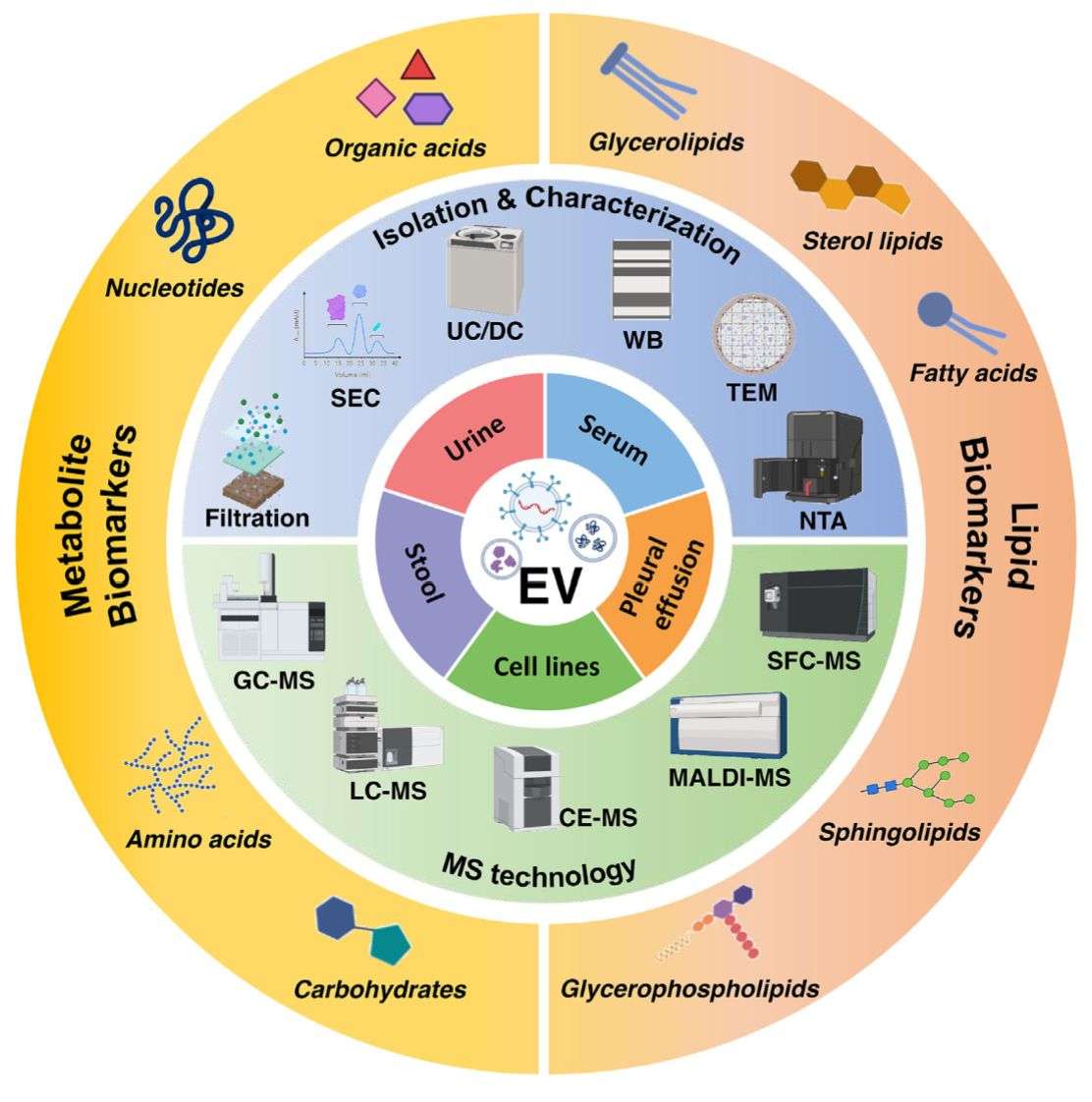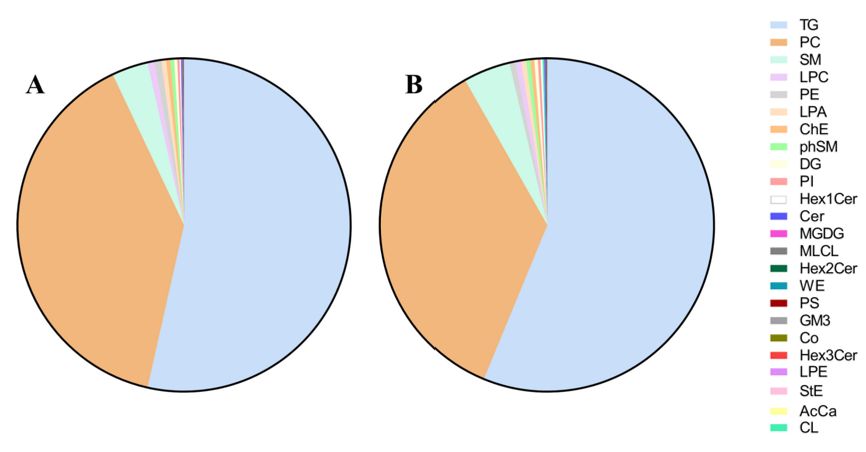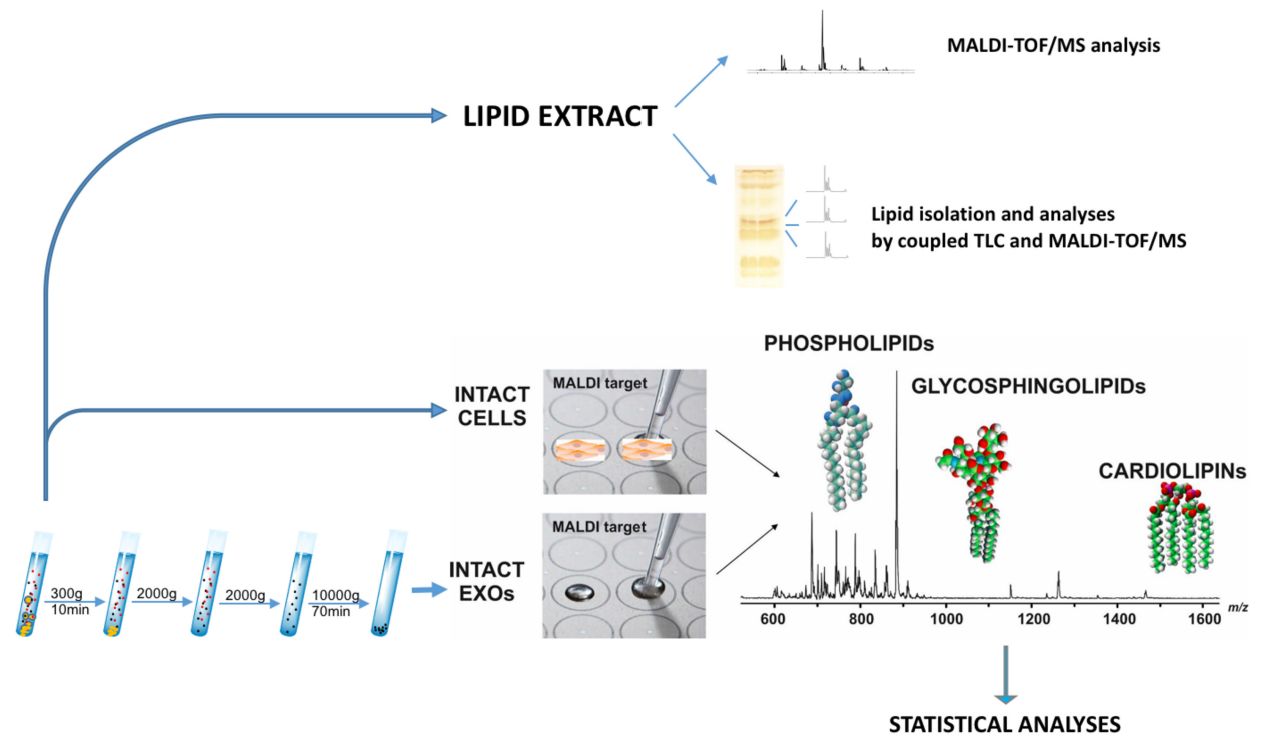Lipidomics and Metabolomics in Exosome Research
Exosomes are tiny vesicles secreted by cells carrying a variety of proteins, nucleic acids, lipids, and metabolites, and are increasingly recognized as key players in intercellular communication. The protein content of exosomes has been extensively studied, and the importance of their lipid and metabolite composition has received increasing attention. This is where exosome lipidomics and metabolomics analyses come into play, providing powerful insights into the complex workings of these tiny messengers. In recent years, exosomal lipidomics and metabolomics analyses have become increasingly valuable in biomedical research and clinical applications.
What are Exosomal Lipidomics and Metabolomics?
Exosomal lipidomics refers to the comprehensive analysis of lipid species present in exosomes, including glycerolipids, glycerophospholipids, sphingolipids, sterol lipids, and fatty acids.
Exosomal metabolomics focuses on the identification and quantification of small molecule metabolites packaged in exosomes, such as amino acids, organic acids, nucleotides, and other biomolecules.
 Figure 1. Advanced MS-based technologies for EV metabolomics and lipidomics. (L. Bai, et al., 2023)
Figure 1. Advanced MS-based technologies for EV metabolomics and lipidomics. (L. Bai, et al., 2023)
Applications of Exosomal Lipidomics and Metabolomics
Biomarker Discovery - Exosomal lipid and metabolite profiles can serve as potential biomarkers for diagnosis, prognosis, and monitoring of a variety of diseases, including cancer, neurodegenerative diseases, cardiovascular diseases, and metabolic disorders.
Mechanistic Insight - Analysis of exosomal lipidome and metabolomics profiling can provide insight into the cellular processes and signaling pathways that lead to alterations in exosomal lipid and metabolite composition, elucidating the underlying pathophysiology of disease.
Therapeutic Target Identification - Exosomal lipidomic and metabolomic assays can help identify new therapeutic targets and develop targeted therapies by elucidating the role of specific lipids and metabolites in disease progression.
Drug Monitoring - Exosomal lipid and metabolite profiling can be used to monitor the pharmacodynamic and pharmacokinetic properties of therapeutic agents, allowing optimization of drug regimens and assessment of drug efficacy.
Intercellular Communication - The study of the exosome lipidome and metabolome can reveal the role of exosomes in mediating intercellular communication and their involvement in physiological and pathological processes.
Exosome Lipidomics and Metabolomics Assay Processes
1. Exosome Isolation
Isolation of exosomes from biological samples (e.g., cell culture media, blood, or other body fluids) using techniques such as ultracentrifugation, size exclusion chromatography, or immunoaffinity-based methods.
2. Extraction of Lipids and Metabolites
Extract lipids and metabolites from isolated exosomes using appropriate solvent-based extraction methods.
3. Assay Analysis
Analyze lipids and metabolites using advanced techniques such as:
Liquid Chromatography-Mass Spectrometry (LC-MS) for lipidomics
Gas Chromatography-Mass Spectrometry (GC-MS) or Nuclear Magnetic Resonance (NMR) spectroscopy for metabolomics
4. Data Analysis
Using bioinformatics tools and databases to process and analyze acquired mass spectrometry or NMR data to identify and quantify lipid species and metabolites present in exosomal samples.
Advances in Exosomal Lipidomics and Metabolomics Research
- Lipid Rafts and Membrane Dynamics
Studies have shown the enrichment of specific lipid classes such as sphingolipids and cholesterol in exosomes, suggesting that they play a role in exosome biosynthesis and function.
- Metabolic Reprogramming
Exosome metabolomics has uncovered changes in the levels of key metabolites (e.g., amino acids, nucleotides, and energy-related molecules) in a variety of disease states, reflecting metabolic reprogramming of the cells of origin.
- Therapeutic Targeting
Strategies are being developed to manipulate exosomal lipid and metabolite composition for therapeutic purposes, such as delivering therapeutic lipids or metabolites or blocking the transfer of disease-related lipids and metabolites.
Research Cases
- Lipidomic Characterization of Exosomes as a Candidate Biomarker for Identifying Hepatocellular Carcinoma
Exosomes and their lipid content serve as potential diagnostic biomarkers for monitoring hepatocellular carcinoma in patients with cirrhosis. Researchers isolated exosomes from the plasma of patients with cirrhosis and used ultra-high-resolution mass spectrometry for untargeted lipidomics. Four lipid classes were depleted in HCC exosomes compared to non-hepatocellular carcinoma (HCC) exosomes. These changes in exosome lipid composition associated with HCC reflect alterations in glycerophospholipid metabolism, iron death, and retrograde endogenous cannabinoid signaling. This study identifies candidate biomarkers for early detection of HCC.
 Figure 2. Distribution of lipid classes in non-HCC and HCC exosomes. (Sanchez JI, et al., 2021)
Figure 2. Distribution of lipid classes in non-HCC and HCC exosomes. (Sanchez JI, et al., 2021)
- Detection of Potential Biomarkers in Melanoma Cell Exosomes by Lipidomics
Melanoma is one of the deadliest skin cancers. By analyzing the lipid profiles of melanoma cell lines, researchers have found that these cell lines have different propensities for bone metastasis. Using ultracentrifugation to isolate exosomes from cell supernatants and comparing their lipid composition, potential lipid biomarkers for different migration and invasiveness of melanoma cells were identified. The results show that saturated fatty acid tails are more numerous and shorter in less metastatic cells compared to highly metastatic cells. In addition, the investigators identified a phospholipid bisphosphate as a specific lipid marker for exosomes.
 Figure 3. Lipidomics workflow for melanoma cell exosomes. (Lobasso S, et al., 2021)
Figure 3. Lipidomics workflow for melanoma cell exosomes. (Lobasso S, et al., 2021)
Today We Offer
At the forefront of exosome research, Creative Biostructure helps clients realize the potential of exosomal lipidomics and metabolomics. We offer a comprehensive range of exosome services and products to help researchers delve deeper into complex exosomal lipid and metabolite profiles. From exosome isolation and characterization to cutting-edge analytical techniques, we provide the tools and expertise to unravel the complex interactions of lipids and metabolites within exosomes, paving the way for the discovery of novel biomarkers, the development of therapeutics, and a deeper understanding of cellular communication. Feel free to contact us for more information.
References
- L. Bai, et al. Mass spectrometry-based extracellular vesicle micromolecule detection in cancer biomarker discovery: An overview of metabolomics and lipidomics. VIEW. 2023. 4(5): 20220086.
- Sanchez JI, et al. Lipidomic Profiles of Plasma Exosomes Identify Candidate Biomarkers for Early Detection of Hepatocellular Carcinoma in Patients with Cirrhosis. Cancer Prev Res (Phila). 2021. 14(10): 955-962.
- Lobasso S, et al. A Lipidomic Approach to Identify Potential Biomarkers in Exosomes From Melanoma Cells With Different Metastatic Potential. Front Physiol. 2021. 12: 748895.